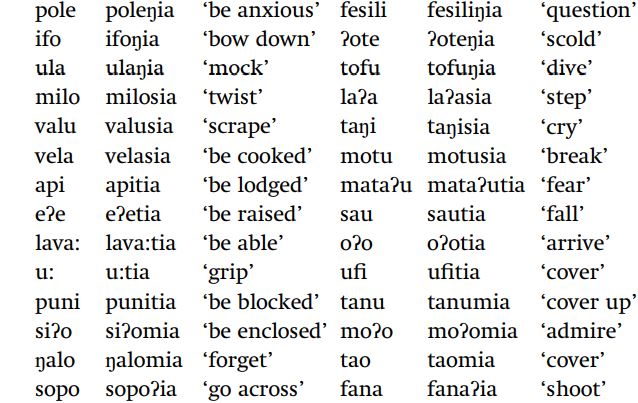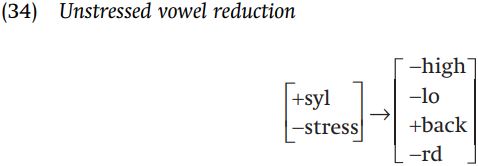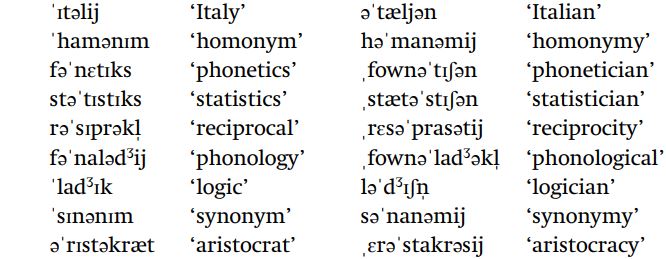


 Grammar
Grammar
 Tenses
Tenses
 Present
Present
 Past
Past
 Future
Future
 Parts Of Speech
Parts Of Speech
 Nouns
Nouns
 Verbs
Verbs
 Adverbs
Adverbs
 Adjectives
Adjectives
 Pronouns
Pronouns
 Pre Position
Pre Position
 Preposition by function
Preposition by function 
 Preposition by construction
Preposition by construction
 Conjunctions
Conjunctions
 Interjections
Interjections
 Grammar Rules
Grammar Rules
 Linguistics
Linguistics
 Semantics
Semantics
 Pragmatics
Pragmatics
 Reading Comprehension
Reading Comprehension|
Read More
Date: 2023-12-05
Date: 2024-06-27
Date: 2024-03-07
|
The following data from Samoan illustrate the very important point that it is wrong to think of deriving underlying forms by chopping off affixes from some single column of data. In the first set of examples, our initial task is to deduce the underlying form of each of the verb roots and the affix for the perfective form.


Examples such as oloia, aŋaia, and usuia suggest that the perfective suffix is -ia, and the simple form of the verb reflects the underlying form of the root. Examples such as seŋi ~ seŋia or lele ~ lele suggest a phonological rule, since the combination of the presumed stems seŋi and lele with the perfective affix -ia would result in the incorrect forms *seŋiia, *leleia. However, this problem can be corrected by positing a phonological rule which deletes a front vowel when it is preceded by a front vowel. In the formalization of the rule, we say that the second front vowel is replaced by zero, which means that it is deleted.

An alternative hypothesis would be that [i] is inserted between a back vowel and the vowel [a], if we were to presume that the perfective suffix is underlyingly /a/.

This latter rule is more complicated than (28). Additional data will show that, in addition, this would just be plain wrong. We abandon the idea of inserting the vowel i and conclude that the underlying form of the perfective suffix must be -ia, hence there must be a rule deleting a front vowel after a front vowel. We would then conclude that the underlying representation of roots is best revealed in the simple verb, rather than the perfective, since the simple form of the verb shows whether the stem ends with /i/, a vowel which may be deleted in the perfective.
A rather different conclusion about arriving at underlying forms would have to be drawn from the following additional Samoan examples.


Here, we see that the perfective form of the verb contains a consonant which is not present in the simple form. That consonant can be any one of l, f ŋ, s, t, m or ʔ, given these data. An attempt to predict the nature of that consonant by an insertion rule proves fruitless. We could attempt to insert an appropriate consonant on the basis of the preceding vowel: but while l appears after u, so do f ([ulufia]), ŋ ([tofuŋia]), and s ([valusia]); and while f appears after o, so do ŋ ([ifoŋia]), m ([ŋalomia]), and s ([milosia]). In short, it is simply impossible to predict from anything in the environment what the consonant of the perfective is going to be, if we start with the simple form as the underlying form: that consonant must be part of the underlying representation of the root. Thus the underlying forms of this second set of roots would be as follows.

The postulation of underlying consonants at the end of these roots entails the addition of a phonological rule, in order to account for the surface form of the simple verb where there is no final consonant. Noting that no word ends in a consonant phonetically in these examples, we can postulate the following rule of final consonant deletion.

The underlying forms of these verbs can be heuristically derived by eliminating the perfective affix -ia from the perfective form. However, notice that we made a different heuristic assumption for the first group of roots, which underlyingly ended in a vowel. The point is that an underlying representation is whatever is required to correctly predict all of the surface variants of a given morpheme: it does not necessarily derive from any one column in a paradigm.
It is also important to understand the difference between saying that the underlying form is the simple form, or is the perfective form, and saying that we may best learn what the underlying form is by looking at the perfective, or simple form, or some other form. The underlying form of the word for ‘stand’ is /tu:l/. We learn that this is the underlying form by comparing the simple form [tu:] and the perfective [tu:lia] and understanding that the perfective form preserves important information about the underlying form that is lost in the simple form. But the perfective form itself is [tu:lia] – this is not the underlying form.
Palauan. The language Palauan provides a second clear illustration of the point that one cannot always arrive at the correct underlying representation by looking at any single column in the paradigm. In this language, the underlying form of the word does not actually surface as such in any form of a word. Consider the following examples:

The prefix for the present middle is apparently /mə/, the future suffix (found in the future conservative and the future innovative) is -l, and the innovative suffix is -al. The position of stress can be predicted by a simple rule: the final syllable is stressed if it ends in two consonants, otherwise the second to last (penultimate) syllable is stressed.
The fundamental problem of Palauan is how to predict vowel quality in the root. Notice that the root meaning of the word for ‘cover’ has three surface realizations: dáŋəb, dáŋəb, and dəŋób. Looking at all of the data, we notice that the only full vowel in the word is the stressed vowel, which suggests that unstressed vowels are neutralized to schwa.

Note that this rule has no context: it does not matter what precedes or follows the unstressed vowel.
In order to predict that the stressed first vowel in the word for ‘cover’ is [a], that choice of vowel must be part of the underlying representation, giving the partial solution /daŋVb/. In contrast, the first vowel of the word for ‘pull out’ must be specified as [e], since that is the vowel which appears in this word when the first vowel is stressed, giving /teʔVb/. By the same reasoning, the second vowel of the word for ‘cover’ must be [o], since that is the realization which the vowel has when it is stressed, and the second vowel of the word for ‘pull out’ must be [i]. Thus, the underlying forms of the stems given above would be the following.

The underlying form of a verb in Palauan is a rather abstract object, something which is never revealed in any single surface form. Rather, it must be deduced by looking at information which is manifested in a number of different morphologically related words derived from a single stem.
English. A similar example can be found in English, as the following examples show. We will ignore other alternations and focus only on vowel alternations. Thus, for example, alternations such as the one between k and s can be ignored. There are many idiolectal differences in the pronunciation of certain words such as economy, where some people pronounce the word as [ijˈkanəmij] and others pronounce it as [əˈkanəmij]: only attempt to account for the pronunciations given here.


As in Palauan, there is an alternation between stressed full vowel and unstressed schwa. We assume underlying stems with multiple full vowels, e.g. /manatown/, /tεlεgræf/, /εpɪgræf/, /dεmakræt/, /fownaladʒ /, etc. But not every unstressed vowel is reduced: cf., for example, ˈrɛlətɪv, ˈdijfεkt, ˈmanətown where the unstressed vowel is in a closed syllable (followed by one or more consonants within that syllable).
Tonkawa: reaching the analysis step-by-step. The following examples will illustrate the logic that leads to seeing the correct underlying forms, in explaining variations found in the verb root in Tonkawa (Texas). You must first give a morphological analysis of the data, identifying the morphemes for progressive, present, first-singular object, and third-plural object; you must also set forth initial hypotheses about the underlying forms of roots. The data to be accounted for are as follows.

Every word in this set ends with oʔ, and the verb forms have a third-person subject, suggesting that -oʔ marks third-person subject. Comparing the habitual present and present progressive form, we see that the present progressive is marked by a suffix, -n- or -Vn- before the suffix -oʔ. An object is marked by a prefix, we- for third-plural object and ke- for first-singular object. What remains is the verb root.
|
|
|
|
تفوقت في الاختبار على الجميع.. فاكهة "خارقة" في عالم التغذية
|
|
|
|
|
|
|
أمين عام أوبك: النفط الخام والغاز الطبيعي "هبة من الله"
|
|
|
|
|
|
|
قسم شؤون المعارف ينظم دورة عن آليات عمل الفهارس الفنية للموسوعات والكتب لملاكاته
|
|
|